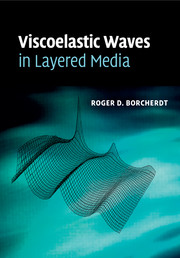Book contents
- Frontmatter
- Contents
- Preface
- 1 One-Dimensional Viscoelasticity
- 2 Three-Dimensional Viscoelasticity
- 3 Viscoelastic P, SI, and SII Waves
- 4 Framework for Single-Boundary Reflection–Refraction and Surface-Wave Problems
- 5 General P, SI, and SII Waves Incident on a Viscoelastic Boundary
- 6 Numerical Models for General Waves Reflected and Refracted at Viscoelastic Boundaries
- 7 General SI, P, and SII Waves Incident on a Viscoelastic Free Surface
- 8 Rayleigh-Type Surface Wave on a Viscoelastic Half Space
- 9 General SII Waves Incident on Multiple Layers of Viscoelastic Media
- 10 Love-Type Surface Waves in Multilayered Viscoelastic Media
- 11 Appendices
- References
- Additional Reading
- Index
1 - One-Dimensional Viscoelasticity
Published online by Cambridge University Press: 29 October 2009
- Frontmatter
- Contents
- Preface
- 1 One-Dimensional Viscoelasticity
- 2 Three-Dimensional Viscoelasticity
- 3 Viscoelastic P, SI, and SII Waves
- 4 Framework for Single-Boundary Reflection–Refraction and Surface-Wave Problems
- 5 General P, SI, and SII Waves Incident on a Viscoelastic Boundary
- 6 Numerical Models for General Waves Reflected and Refracted at Viscoelastic Boundaries
- 7 General SI, P, and SII Waves Incident on a Viscoelastic Free Surface
- 8 Rayleigh-Type Surface Wave on a Viscoelastic Half Space
- 9 General SII Waves Incident on Multiple Layers of Viscoelastic Media
- 10 Love-Type Surface Waves in Multilayered Viscoelastic Media
- 11 Appendices
- References
- Additional Reading
- Index
Summary
The behavior of many materials under an applied load may be approximated by specifying a relationship between the applied load or stress and the resultant deformation or strain. In the case of elastic materials this relationship, identified as Hooke's Law, states that the strain is proportional to the applied stress, with the resultant strain occurring instantaneously. In the case of viscous materials, the relationship states that the stress is proportional to the strain rate, with the resultant displacement dependent on the entire past history of loading. Boltzmann (1874) proposed a general relationship between stress and strain that could be used to characterize elastic as well as viscous material behavior. He proposed a general constitutive law that could be used to describe an infinite number of elastic and linear anelastic material behaviors derivable from various configurations of elastic and viscous elements. His formulation, as later rigorously formulated in terms of an integral equation between stress and strain, characterizes all linear material behavior. The formulation, termed linear viscoelasticity, is used herein as a general framework for the derivation of solutions for various wave-propagation problems valid for elastic as well as for an infinite number of linear anelastic media.
Consideration of material behavior in one dimension in this chapter, as might occur when a tensile force is applied at one end of a rod, will provide an introduction to some of the well-known concepts associated with linear viscoelastic behavior. It will provide a general stress–strain relation from which stored and dissipated energies associated with harmonic behavior can be inferred as well as the response of an infinite number of viscoelastic models.
- Type
- Chapter
- Information
- Viscoelastic Waves in Layered Media , pp. 1 - 18Publisher: Cambridge University PressPrint publication year: 2009



